Ducted Air Conditioner Size Chart for Northern Beaches NSW
Choosing the right size ducted air conditioning system for a home on the Northern Beaches in Sydney, NSW, requires calculating the cooling and heating needs for the entire home or specific zones, factoring in the local coastal climate, home size, insulation, and design. Ducted systems distribute air through ducts to multiple rooms, offering whole-home or zoned climate control. Sizing is measured in kilowatts (kW) of cooling/heating capacity. Below is a guide to determine the appropriate size for your home.
| Home Type | Total Area (m²) | Number of Bedrooms | System Capacity (kW) | Suggested Zones |
|---|---|---|---|---|
| Small Home | 100–150 | 2–3 | 10–14 | 1–2 |
| Medium Home | 150–200 | 3–4 | 14–18 | 2–3 |
| Large Home | 200–300 | 4–6 | 18–25 | 3–4 |
| Very Large Home | 300+ | 6+ | 25–30+ | 4+ |

Key Factors for Sizing a Ducted Air Conditioner
- Home Size and Layout
- Measure the total floor area (m²) to be cooled/heated, excluding non-conditioned spaces (e.g., garages).
- Note ceiling height (standard ~2.4m; higher ceilings increase capacity needs).
- Consider the number of rooms and zoning (e.g., separate day/night zones).
- Cooling Capacity Rule of Thumb
- For Sydney’s temperate coastal climate, use 0.125–0.15 kW per square meter for well-insulated homes with moderate sun exposure. Adjust for:
- Sun exposure: Add 10–20% for homes with large north- or west-facing windows.
- Insulation: Poor insulation may require 20–30% more capacity.
- Ceiling height: Add ~10% per 0.5m above 2.4m.
- Occupancy: Add ~0.5 kW per extra person (beyond average household size).
- For Sydney’s temperate coastal climate, use 0.125–0.15 kW per square meter for well-insulated homes with moderate sun exposure. Adjust for:
- Heating Capacity (Reverse-Cycle)
- Most ducted systems are reverse-cycle, providing heating for the Northern Beaches’ mild winters (8–18°C).
- Heating capacity should match or slightly exceed cooling needs for year-round comfort.
- Zoning and Airflow
- Ducted systems can be zoned (e.g., living areas vs. bedrooms), reducing capacity needs if not all areas are conditioned simultaneously.
- Proper duct design ensures efficient airflow; undersized ducts increase energy use.
- Northern Beaches Climate
- Coastal humidity makes rooms feel warmer, so prioritise systems with dehumidification.
- Inverter technology ensures energy efficiency and consistent temperatures.
General Sizing Guide
Based on industry standards and web sources:
- Small home (100–150 m², 2–3 bedrooms): 10–14 kW
- Medium home (150–200 m², 3–4 bedrooms): 14–18 kW
- Large home (200–300 m², 4–6 bedrooms): 18–25 kW
- Very large home (300+ m²): 25–30+ kW
Example Calculation
For a 200 m² home on the Northern Beaches with standard 2.4m ceilings, good insulation, and moderate sun exposure:
- Base requirement: 200 m² x 0.125 kW/m² = 25 kW.
- Adjust for large windows (+10%): 25 kW x 1.1 = 27.5 kW.
- Adjust for zoning (e.g., 70% of homes conditioned at once): 27.5 kW x 0.7 = ~19.25 kW.
- Recommended system: An 18–20 kW ducted system (e.g., Daikin Premium Inverter or Mitsubishi Electric PEAD series).
Recommendations for Northern Beaches
- Small homes (100–150 m²): A 10–14 kW system suits a 2–3 bedroom home with 1–2 zones (e.g., Fujitsu ARTG45LHTA).
- Medium homes (150–200 m²): A 14–18 kW system for a 3–4 bedroom home with 2–3 zones (e.g., Panasonic Ultra Slim Ducted).
- Large homes (200–300 m²): An 18–25 kW system for a 4–6 bedroom home with multiple zones (e.g., Daikin FDYQ series).
- Brands: Daikin, Mitsubishi Electric, Fujitsu, and Panasonic are reliable for efficiency and coastal durability.
- Zoning: Install a zoning system (e.g., AirTouch or MyAir) to control different areas, reducing energy use when rooms are unoccupied.
Additional Tips
- Professional Heat Load Assessment: Engage a local expert, such as Platinum AC, for a detailed heat load calculation. They’ll assess insulation, window orientation, roof type, and duct layout.
- Energy Efficiency: Choose high star-rated inverter systems to lower running costs, especially given humidity and frequent use. Look for systems with variable speed fans.
- Installation: Ducted systems require significant space for ducts and the indoor unit (e.g., in the ceiling or under the floor). Ensure licensed installers design ducts for optimal airflow.
- Regulations: Outdoor units must comply with NSW noise and placement rules (e.g., not on walls facing primary roads). Ducted systems are typically exempt from development, but confirm with your local council.
- Maintenance: Coastal salt air can corrode units, so choose corrosion-resistant models and schedule regular maintenance.
Next Steps
- Provide your home’s floor area, number of rooms, ceiling height, and zoning preferences for a tailored recommendation.
- Contact Platinum AC Northern Beaches ducted air conditioner installers for on-site quotes to confirm system capacity and duct design.
If you share specific details about your home (e.g., size, layout, or insulation), we can refine the sizing estimate further!



